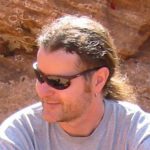Link to Pubmed [PMID] – 25799062
Link to DOI – 10.1038/ncb3137
Nat Cell Biol 2015 Apr; 17(4): 445-57
Cellular mechanisms underlying the development of left-right asymmetry in tissues and embryos remain obscure. Here, the development of a chiral pattern of actomyosin was revealed by studying actin cytoskeleton self-organization in cells with isotropic circular shape. A radially symmetrical system of actin bundles consisting of α-actinin-enriched radial fibres (RFs) and myosin-IIA-enriched transverse fibres (TFs) evolved spontaneously into the chiral system as a result of the unidirectional tilting of all RFs, which was accompanied by a tangential shift in the retrograde movement of TFs. We showed that myosin-IIA-dependent contractile stresses within TFs drive their movement along RFs, which grow centripetally in a formin-dependent fashion. The handedness of the chiral pattern was shown to be regulated by α-actinin-1. Computational modelling demonstrated that the dynamics of the RF-TF system can explain the pattern transition from radial to chiral. Thus, actin cytoskeleton self-organization provides built-in machinery that potentially allows cells to develop left-right asymmetry.
